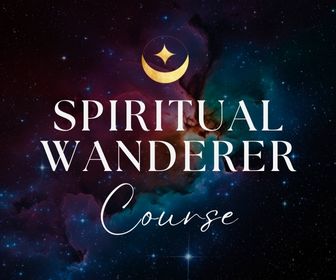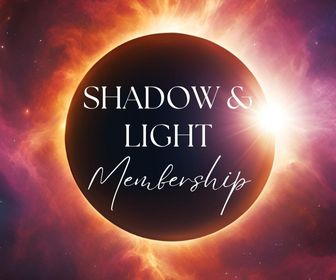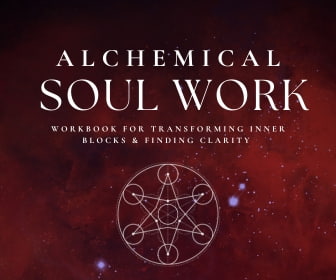Your breath is one of the most sacred, yet forgotten, parts of your daily existence.
As one of the few functions in the human body that is both conscious and unconscious, the breath is a conduit of life. It is the physical manifestation of your chi (qi), prana, or lifeforce energy. And you do it 23,000 times a day.
Most of all, your breath is always there for you, 24/7, until the day you die. It is there not only to help animate your body, but also to help it heal, purge old energy and toxins, and invite in whatever is new and invigorating.

Spiritual Wanderer Course:
Find your deepest path and purpose in life as a spiritual wanderer. In this immersive course, you get 3+ hours of content, workbooks, meditations, a premium test, and more!
Your breath is your most ancient friend and it is always there to call upon when you need help.
Isn’t that beautiful? Isn’t that comforting? Isn’t that magical?
Whenever you need a burst of fresh energy, breathe. Whenever you need to process heavy emotions, breathe. Whenever you need to calm down, breathe.
You have an anchor, a doorway into immediate meditation within you wherever you go and whatever you do – and that’s what’s so bewitching about breathwork. Breathwork simply takes this natural, primordial bodily function and makes a conscious practice out of it.
In this article, I’m going to explore a few different varieties of breathwork – and they all beautifully complement the inner work practices of self-love, inner child work, and shadow work that are needed for deepening the process of spiritual awakening.
Table of contents
What is Breathwork?

While ancient, ‘breathwork’ is a term that first originated in the 1970s, referring to the practice of consciously directing the breath. The goal of breathwork is to positively alter the body, mind, heart, or spirit and produce therapeutic inner transformation. There are numerous forms of breathwork in existence today. While some of them go right back to the old yogic practices of pranayama, others are relatively new such as the Wim Hof Method.
Benefits of Breathwork

Breathing is the fundamental unit of risk, the atom of inner courage that leads us into authentic living. With each breath, we practice opening, taking in, and releasing. Literally, the teacher is under our nose. When anxious, we simply have to remember to breathe.”
– Mark Nepo
There’s an overwhelmingly vast array of benefits associated with regularly practicing breathwork. While some are scientifically proven, others are waiting to be validated (yet are quite self-evident!). Here’s what you can expect to experience from making breathwork an everyday habit:

Shadow & Light Membership:
⭐️⭐️⭐️⭐️⭐ "Shadow and Light’s weekly guidance always rings true to my heart. Thanks for acknowledging my shadows and inviting my inner light. I always get excited to open the Shadow and Light emails on Sunday!" – Angela M.
- Relaxes your nervous system
- More calmness (and less anxiety/stress)
- More self-acceptance (and less depression)
- Enhances overall mental health
- Improves immune function (which means you stay healthy for longer)
- Alkalizes your blood and decreases inflammation in the body
- Enhances mental clarity and focus
- More energy and vitality
- Can result in a mystical experience or deep spiritual insights
- Boosts feelings of joy and happiness
- Aids creativity and intuition
- Enhances feelings of connection with others
- Increases mindfulness and appreciation of life
On a side note, some breathwork practices also have mind-altering effects (in other words, they get you high!), which many people find enjoyable.
In fact, the term ‘breathwork’ rose in popularity in the 1960’s-70’s mostly thanks to LSD researchers Dr. Stanislav and Christina Grof who created their Holotropic Breathwork model thanks to their findings.
Breathwork & Spiritual Awakening

You might be wondering what on earth your breath has to do with spiritual awakening, but my response is how isn’t the breath related to your spiritual path?!
The word ‘spirit’ itself derives from the Latin word spiritus which literally translates to “breathing; breath; breath of a god” (1). There are also other connections between breath and spirit in many other languages as well such as Hebrew (ruach meaning “spirit, breath, wind, and/or mind”) and Greek (pneuma meaning “air, soul, breath”).
So here we can see that breath and spirit are inextricably linked – and as such, breathwork is a powerful and fundamental practice on our spiritual awakening journeys.
Learning to consciously work with our breath, whether through meditation, yoga, nature bathing, or simple mindfulness practices can help us to bridge the gap between the mind and heart, body and soul.
By tuning into the sacred cycles of the in-and-out breath, we learn about the rhythms of life, our mental states, and how to arrive fully and completely in the present moment. The breath heals us, awakens us, still us, and reveals to us our True Nature.
Warning

Before we dive deeper into this topic, I want to issue a warning.
Breathwork, for some people, particularly those with pre-existing heart problems, can be dangerous. It’s best to speak to a qualified medical practitioner before attempting any form of breathwork, particularly if your health is fragile.
Pregnant women should also seek professional advice first. Furthermore, some forms of breathwork are best practiced with a qualified practitioner, such as Holotropic and Rebirthing breathwork.
Would you like to save this?
Your information will never be shared.
Above all, if you feel intense discomfort or feelings of unsafety during this practice (either by yourself or with another person), stop immediately. The beauty of breathwork is that you can stop at any time, and indeed you should stop if at any point it becomes too much for you.
5 (Intensely Transformative) Types of Breathwork

Where to start? There are many varieties of breathwork that can aid your spiritual healing and growth, and below I’ll summarize them:
1. Pranayama
Arguably the oldest form of ‘breathwork’ there is, pranayama (a Sanskrit word that translates to “breath control”) is a series of yogic breathing techniques that are designed to liberate the flow of prana (life force energy) and increase spiritual self-realization.
Pranayama can either be practiced alongside yoga asanas (poses) or by itself. There are eight types of pranayama with dozens of individual methods described in the Vedas (or ancient Indian religious texts). Some of the more common ones are Skull Shining Breath (or Kapalabhati), Alternate Nostril Breathing (or Nadi Shodhan), and Conqueror Breath (or Ujjayi).
2. Holotropic breathwork

Created by transpersonal Czech psychiatrists Stanislav and Christina Grof, holotropic breathwork was created in the 1970s as a way of helping people to experience deep inner healing and transformation.
After studying and experiencing the therapeutic effects of the drug LSD, the Grof’s developed their holotropic model after the ban of this psychedelic drug in the 1960s. The intention was to design an experience that was similar to LSD with its mind-altered effects but without the side effects (and legal issues).
Holotropic breathwork is often practiced alongside the rhythm of primal music, with participants breathing rapidly under instruction for up to two hours or more. Afterward, the practice is accompanied by drawing mandalas and discussing what happened.
Holotropic breathwork is a breathing technique that must be practiced with a qualified practitioner – so please be wary of trying it by yourself (having a safe holding space is important). The ultimate goal is to access higher states of consciousness and connect with the Soul.
3. Rebirthing breathwork
Rebirthing breathwork is a breathing technique that was developed by visionary Leonard Orr in the 1970s. Orr reported having re-lived his own birth in a bathtub, which is what inspired him to devise this method.
The goal of this technique is to connect you with the subconscious mind, release traumatic childhood memories, and experience a kind of invigorating ‘rebirth’ (hence the name).
Rebirthing breathwork utilizes a circular breathing technique alongside the guidance of a trained facilitator. Some forms of rebirthing are conducted in a bathtub to mimic the process of being born (or reborn in this case). Such a practice can be a powerful inner child work practice that can enable you to heal and empower the wounded inner child we all carry.
4. Shamanic breathwork

Shamanic breathwork is a modern adaptation of old circular breathing techniques with the purpose of getting a person in touch with their inner healer (shaman). Such a practice was developed primarily by visionary teacher and shaman Linda Star Wolf in the 1990s.
During a shamanic breathwork experience, participants begin by smudging, chanting, and setting an intention. They then breathe rhythmically to primal music (such as the sound of drums), with some practitioners incorporating chakra healing, spirit animal contact, and other practices into the breathwork session.
Other than connecting with your inner shaman, shamanic breathwork’s aim is to help you experience more wholeness, healing, and inner guidance.
5. Wim Hof breathwork
A relatively new technique (although based on ancient pranayama methods), the Wim Hof method was developed by Dutch extreme athlete Wim Hof – also known as “The Iceman.”
For over a decade, we've strived to make this website a haven of free, valuable information. Imagine a world where this knowledge wasn't readily available. If this post sparked a meaningful insight or helped you in any way, please consider a donation as a heartfelt "thank you" for keeping this resource free. Every contribution, big or small, allows us to keep giving back.
Hof earned his nickname thanks to a series of intense physical feats, such as being able to withstand freezing cold temperatures and ice baths for prolonged periods of time.
His method involves three central pillars: exposure to cold, breathing (controlled hyperventilation), and meditation. The breathwork part of his method involves taking thirty power breaths and then after that, taking a deep inhale and retaining your breath as long as comfortable, then exhaling. Afterward, one must inhale deeply for another 10-15 seconds, retain, and then exhale.
This breathwork process is then repeated for up to three more rounds. The Wim Hof method is aimed toward increasing physical and mental wellbeing and has been scientifically linked to a number of benefits.
Other forms of breathwork include:
- Vivation
- Integrative breathwork
- Transformational breathwork
- Biodynamic breathwork
- Clarity breathwork
- Zen Yoga Breathwork
If I’ve missed out on any let me know in the comments!
Breathwork and Spiritual Healing

Deep, slow, and intentional breaths, that expand and contract the belly, allow for more oxygen to enter the body … When this respiration is consistent, unnecessary tension will not build up in the body or in the mind. When the body and mind are free from allocating energy to unnecessary tension, that energy can be more directly utilized in the process of emotive-psychosynthesis. Deep breathing is the tool of the masters for letting go of old attachments and old emotions and for extracting the wisdom hidden within the experiences of life.
– Ron Teeguarden
As we’ve seen, breathwork can help us on a physical, mental, emotional, and even spiritual level – it’s an immensely powerful healing modality!
What’s essential is setting an intention beforehand. Without a clear intention, it can be difficult to appreciate (and sometimes notice) the benefits and changes brought about by breathwork.
Think about what issue you’re facing in life the most right now. Perhaps the issue is a physical illness. Breathwork can help you with that, but it can also go to the deeper roots of that issue that are often spiritual in nature. (See our article on soul loss for more information.)
By creating a drug-free altered state of consciousness, breathwork helps us to access the realm of our Souls and dip into the ethereal world of Spirit. Some of the greatest discoveries, epiphanies, and breakthroughs you can ever make might be through a breathwork session.
What’s important is that you choose a form of breathwork that resonates with you – this is what will make the process deep and impactful.
By helping us to release deep layers of pain, trauma, and repressed emotion, breathwork liberates energy within us – energy to heal, to transform, and to connect with our True Nature.
Download FREE Breathwork Worksheets!
Go deeper with a breathwork journaling prompt + printable meditation mandala!
6 Easy Breathwork Practices That You Can Practice Alone

The flow of breath plays a large part in determining the overall health of a person, and especially their ability to feel alive, vital, and to express spontaneously.
– R. Johnson
For most of the above breathwork practices, you need a qualified practitioner to help facilitate the process (it’s safer and more effective that way). But understandably, not everyone has time or money to find a breathwork facilitator.
Thankfully there are some gentle but transformative breathwork techniques out there that you can practice alone (or with a friend).
Please note, however, that everyone is different, and some people might find the following techniques too intense. Listen to your body, and if at any point you feel overwhelmed by strong emotions or physical sensations, stop.
Below we’ll explore some simple forms of breathwork that you can (usually) practice by yourself:
1. Alternate Nostril Breathing (a pranayama technique)
Also known as Nadi Shodhana, alternate nostril breathing is an ancient yogic breathwork technique that helps you to calm down and find inner peace. This practice is particularly helpful to those who suffer from chronic stress, anxiety, ungroundedness, or insomnia.
Alternate nostril breathing is also said to enhance mental focus, remove toxins from the body, balance the right and left hemispheres of the brain, and clear the energy channels within the body.
Here is an instructional video:
2. The 4-7-8 Relaxing Breath
This simple practice is perfect for when you’re short on time. It helps you to connect with your body, be present with your emotions, and unwind your nervous system. The basic premise is to breathe in for a count of four, hold four a count of seven, and exhale for a count of eight.
This video will give you an idea of how to practice 4-7-8 breathing:
3. Soft Belly Breathing
In the modern world, a large percentage of us breathe from our chests, not from our abdomen. Unfortunately, this incessant chest-breathing increases stress, nervous tension, and a racing mind that never seems to calm down.
Learning how the belly breath is vital if we are to find our inner center. But frustratingly, those who encourage belly breathing often forget one vital thing: it has to be soft and unforced. Ironically, when we force the belly breath, the result is a feeling of increased anxiety.
As author and breathing practitioner Patrick McKeown writes:
Unlike many modern Western teachers of yoga, who instruct students to breathe hard in order to remove toxins from the body, authentic teachers know that when it comes to breathing, less is more. The traditional Chinese practice of Taoism succinctly describes ideal breathing as ‘so smooth that the fine hairs within the nostrils remain motionless’. True health and inner peace occurs when breathing is quiet, effortless, soft, through the nose, abdominal, rhythmic and gently paused on the exhale. This is how human beings naturally breathed until modern life changed everything.
Therefore, the goal with soft belly breathing isn’t to force any breath, but instead allow the breath to become soft, deep, and abdominal.
This video might help you begin a belly breathing practice:
4. Circular Breathing
Circular breathing (not to be confused with circular musician breathing) needs to be approached gently and mindfully, especially as it’s often used as a consciousness-altering technique.
When we circular breathe, we take a gentle breath in and out without pausing. This is a practice that can be done quietly or out loud (that is, making a noise when breathing out).
As a breathwork technique, circular breathing can release old emotions, cleanse the energetic and emotional body, and even open up the mind to deep spiritual insights.
Here is an instructional video:
5. Visualization Breathing
There are endless forms of visualization that we can use in conjunction with deep breathing – and that’s what makes this breathwork practice so eclectic and adaptable.

Feeling Lost?
The Alchemical Soul Work Workbook provides you with a clear path to clarity through the seven ancient stages of alchemy. With 50+ journaling prompts, you'll dissolve old patterns and forge a stronger connection with your Soul.
Visualization breathing can be uniquely tailored to your needs in the moment; all you need is your breath and creative imagination.
Some common forms of visualization breathing are:
- Visualizing light washing through your body as you inhale and exhale
- Visualizing each of your seven chakras glowing as you breathe into them
- Visualizing air moving through your respiratory system
- Visualizing all stress and illness leaving your body as you exhale
- Breathing in light, breathing out darkness
- Breathing in pain, and breathing out loving-kindness (this is known as the ‘Tonglen’ Buddhist practice)
This video might inspire you:
6. Square Breathing
Square breathing is a wonderfully simple practice and is great for those who struggle to memorize breathing techniques. (It’s also great for kids!)
To do square breathing, simply breathe in for the count of four, hold for the count of four, and exhale for the count of four (4-4-4). You can also visualize forming a square in your mind while doing this breathwork practice if it helps.
In this video, square breathing is explained (instruction starts at 1:06)
This simple breathwork practice helps to ground and center the body and mind. It can also be used before (or during) meditation practice and as a mindfulness technique.
Takeaway
Breathwork is a powerful practice that can accompany you anytime, anywhere, on your life path – quite simply, it works like magic because practically anyone can do it!
Not only is breathwork freely accessible and gloriously straightforward (in most cases), but its ability to aid spiritual healing, growth, and transformation makes it powerfully healing and cleansing.
To start your journey with breathwork, choose one of the above practices (that you can do alone) and dedicate just 2-5 minutes each day to it. To make a solid habit, it’s a good idea to set a regular time, such as in the morning or just before bed. (If you struggle to remember, set a reminder on your phone or calendar!)
If you want to experience the benefits of breathwork firsthand, right now, watch the video below. It’s one of my favorite calming visuals that helps to guide the breath and slow it down almost instantaneously:
What is your favorite breathwork practice and why? I’d love to hear in the comments. Also, if you’ve had any amazing or mind-blowing experiences while doing breathwork, please share in the comments about that as well! I’d love to hear. :)
Three paths to inner transformation – here’s how I can help you go deeper:
1. The Spiritual Wanderer Course: Are you feeling lost, adrift, and unsure of your life's purpose? Gain clarity, focus, and direction on your inner path by uncovering the five archetypes of awakening within you. Learn how to navigate the highs and lows of your inner journey and chart your unique path with 3+ hours of audio-visual content, workbooks, meditations, and a premium test.
2. Shadow & Light Membership: Do you crave consistent support on your spiritual quest? Receive weekly intuitive guidance and learn to embrace your whole self, including your shadow side. Cultivate deeper self-love with our affordable, personalized support.
3. The Alchemical Soul Work Workbook: This powerful psychospiritual tool helps you turn inner blockages into breakthroughs using the ancient wisdom of spiritual alchemy. Through guided prompts and deep self-reflection, you’ll gain clarity, dissolve emotional pain, and reconnect with your Soul’s wisdom. Transform confusion into clarity. Live a more authentic, ensouled life.



 $3
$3




I practice SOMA breath techniques and they have been both liberating and enlightening.
I am more joyous and grateful everyday.
I love my life ❤
Thank you for sharing this Emmy, I’ve never heard of Soma breathwork, but I’m curious to research it more now!
Brilliant. There are so many types of breathwork and no clear guidance in one place as to what is what. I heard about kriya yoga but understand it is a type of pranayama. I tried Chakra Breathing, very powerful method. Holotropic breathwork seems interesting but seems to require investment of time and ££ with a certified practitioner. A cheeky question. When are we going to get a video or a course from you guys on breathwork? :)
I agree with some more videos from Sol and Luna, please.
Incredible timing on this newsletter. Breath work was exactly what I needed to help ground me in this unique season. It was like a warmly received hug to be reminded to breathe. Thank you!
Wow, have recently subscribed to your mailing list and have to say I have enjoyed reading all the articles and practising to adapt them into everyday life. This breathing article was amazing, felt energised, happy, stress free and pain free after practising the breathing, particularly the 1 nostril at a time. Play alot of sports and realised my back was tight and this just eased me afterwards like a hot bath. Thank you for this knowledge. I will be pushing friends and family to LonerWolf as there is something for everyone to have a better life and enjoy the journey. Keep up the great work! Its life changing, especially in challenging times. Greetings from Ireland!
Thank you brother, I’m thankful to hear you’re enjoying what we offer. I’ve grown more fascinated with this topic after a pranayama session we had in a hotel in Bali, it opened our eyes to how much effect it has on your energy and focus levels, I can see how this would be complementary to doing meditation afterward or yoga. The perfect exercises to incorporate into your daily routine in times like these. :)
LonerWolf –
This is The Best! Thank you — from all of us!
My first rebirthing session was from someone trained by Leonard Orr. Since those meetings with my “cosmic obstetrician” – well, yes, I’ve learned how breathing is my best friend. There was a period with Wilhelm Reich based breathwork, however that would go under the heading of “therapy” rather than the category here,,,,there have to be limits somewhere to this comprehensive review. But Bioenergetics – the godchild of Reichian work – involves using various stages of breath to build up complete charge and then discharge, and to release armoring in muscles or organs.
I think of the workshops as being the most intense, rather than one-on-one, because this is where the most vulnerable emotions came up, explored by a motley group of participants, a real laboratory for personal transformation.
Since then, Taoist Universal Healing Garden – formulas as passed down through Mantak Chia, has been my best friend breath’s best friend. Breath and I are a lot calmer now, more used to each other and the peace that comes with long complete yoga. Inspiration (literally “to take in breath”) from all of this has led to some songs on the topic, most plainly “Keep Breathing” and “Breathing Lessons Rhymed”. Of course “God Moves Through Us” would also apply!
This won’t be the first time I’ve forwarded posts from this site. It probably will get forwarded to the most people in my life though! And will be the one I refer to most, thanks to the array of healers and videos I didn’t know about ’til now.
Exponential namaste to you and Luna!
Thank you Savlove, it’s awesome seeing how much is happening in this growing field of breath work. I’m seeing more and more scientific papers come out, and I’ve heard of Bioenergetics quite a bit but have never put proper research into it. I look forward to exploring and trying more of these new techniques in the coming years. :)
I found this article so insightful!! I’ve been doing very basic breathing techniques and this has opened my eyes to so many deeper options I can explore- thank you!!
Thank you for letting me know Elizabeth, it’s wonderful seeing more of these techniques adopted into our daily rituals :)
Hi! I love the article focussing on the different types of Breathwork. As a Shamanic Breathwork practitioner, I am completely dedicated to the path of the breathe.
I wanted to point out that you mentioned the founders of Holotropic, Re-birthing, and Wim Hoff – however you did not mention the founder of Shamanic Breathwork® which has been a trademarked body of work for more than 20 years now by Linda Star Wolf. You can learn more about Star Wolf’s work and lineage here; http://www.shamanicbreathwork.org.
Happy breathing!
Thank you Nikólaus for catching that, we couldn’t find a reliable source for the shamanic breathwork. I appreciate it and will update the article with a link to it soon :)
Aha! It feels good to know that the belly breath is actually supposed to be soft! I’ve been doing them deep when I’m anxious and thinking there’s something wrong with me because I get more stressed Haha. But I still love breathwork, it really can be mindblowing. Thanks Mateo
Heheh indeed, there are so many subtleties in these types of exercises that it’s so easy to do something we don’t even realize once and then turn it into a habit we keep repeating throughout until we notice somethings off or someone points it out. But even that becomes a new layer of understanding on what effects it causes within us such a slight change in rhythm :)
hi mateo, my favourite breathing technique which i discovered myself is, for connecting with the universe, as a self. its for when im not feeling separate and bounded enough, or feelikng like im taking too much on, or giving too much away, do i even exist i dont know how life is going on, how to live…this is what i do: i try to inhale as if, it’s the only work im going to do right now, and i will do as much as i can happily, and in my exhale i just give up control over my breath, for the universe to do the rest. then i pick up where it ends, and do my bit.
I love that, a great exercise in surrendering into the moment through the breath. Thank you for sharing it with us :)
I love this idea too! I am a big fan of Eckart Tolle and I think you should suggest this to him as he talk so much about presence and surrender.
I love you guys work so much. U don’t know how much you’ve helped me.
We love doing what we do because of you guys Neelam :), I appreciate all the lovely messages you all leave.